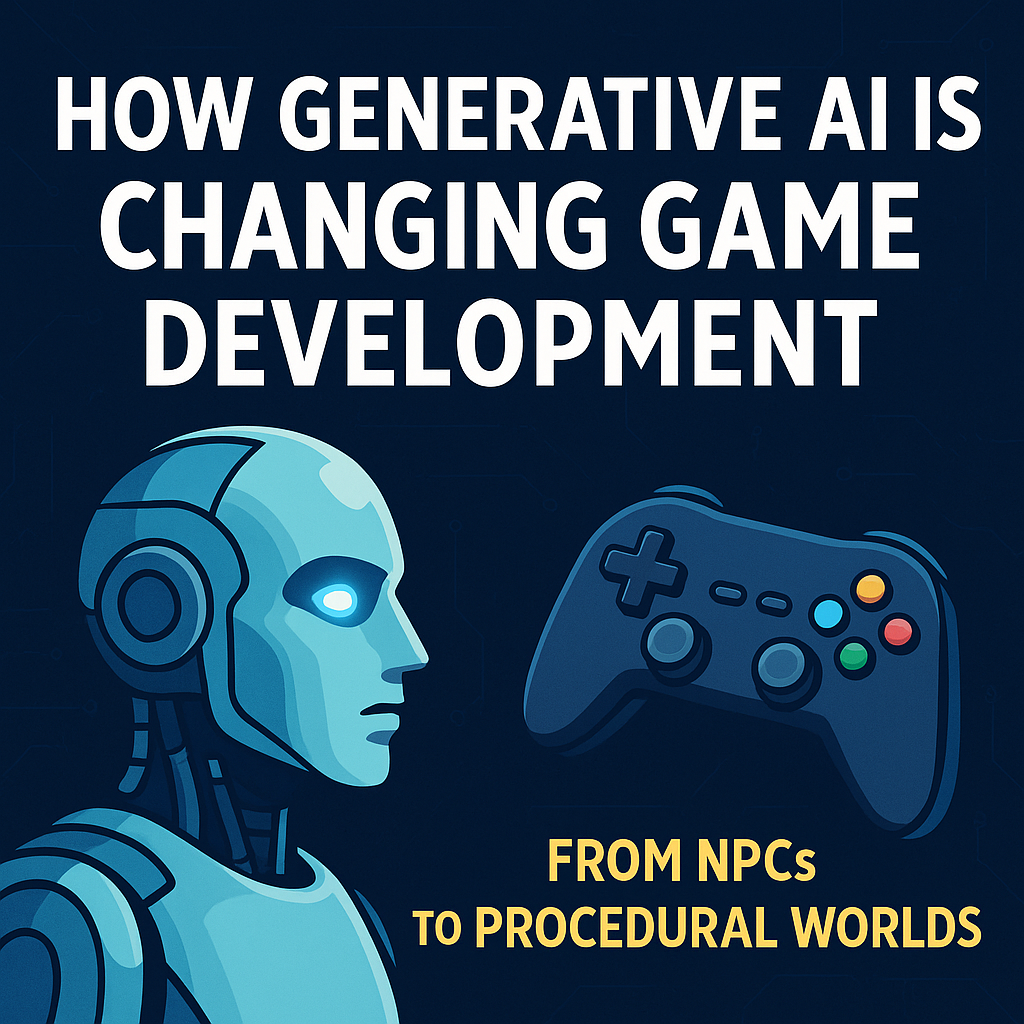How Generative AI is Changing Game Development: From NPCs to Procedural Worlds

How Generative AI is Changing Game Development: From NPCs to Procedural Worlds
🎮 What Is Generative AI in Game Development?
Generative AI refers to algorithms that can create new content — such as images, text, code, or game environments — based on input data. In game development, this means AI systems are no longer just used to control enemy behavior. They're now actively building parts of the game itself.
Whether it’s generating dialogues, characters, landscapes, or quests, generative AI transforms how games are conceived, designed, and played. Developers can now build more expansive, responsive, and replayable game worlds than ever before.
🧠 Intelligent NPCs: From Scripted to Self-Aware
One of the most exciting impacts of generative AI is the evolution of Non-Player Characters (NPCs). Traditionally, NPCs operated via static dialogue trees and pre-programmed actions. Now, with models like OpenAI’s GPT or Meta's LLaMA powering in-game interactions, NPCs can:
- Respond dynamically to player choices
- Adapt to changing game states
- Remember past interactions and adjust behavior
- Generate natural dialogue on-the-fly
This means no more repeating the same canned responses — NPCs can feel alive and emotionally reactive, elevating immersion to an entirely new level.
🧪 Example: In "Project Electric Sheep", an experimental indie title, NPCs powered by AI language models develop unique personalities and can even form relationships with players across playthroughs.
🗺️ Procedural Generation Gets Smarter
Procedural generation is the use of algorithms to automatically create game content — such as levels, maps, or loot — instead of crafting everything by hand.
Generative AI takes this a step further by:
- Designing worlds with narrative logic (not just random noise)
- Blending terrain types and biomes intelligently
- Reacting to player behavior in real time
Instead of fixed dungeons or static maps, players can explore living, breathing ecosystems that shift and evolve, offering a nearly infinite variety of gameplay experiences.
🌍 Example: Games like No Man’s Sky and Minecraft paved the way, but generative AI introduces contextual awareness, enabling smarter world-building based on player profiles, actions, and preferences.
✍️ AI-Powered Storytelling and Quest Design
Generative AI isn't limited to visuals and environments — it's also reshaping narrative design. With the ability to craft branching plots, unique quests, and emotionally resonant moments, AI can:
- Tailor stories to each player’s decisions
- Create dynamic side quests with real consequences
- Generate character backstories that feel personal
- Offer reactive worldbuilding, where the story grows organically
📝 Example: AI Dungeon already demonstrated the potential of narrative models. Modern implementations are blending this with visual storytelling and voice synthesis, creating full story arcs that are truly unique to the player.
🧰 Best Tools and Technologies Leading the AI Revolution
Here are some of the top AI tools and engines that game developers are using today:
- Inworld AI – For creating believable, contextual NPC dialogue
- Scenario.gg – For generating assets using image-based prompts
- Promethean AI – For building 3D environments autonomously
- OpenAI's GPT models – For in-game chat and quest generation
- Charisma.ai – For emotionally intelligent character writing
- Unity Muse & Unreal Engine AI – Native generative tools within top engines
These tools enable small teams to do the work of dozens, cutting production time while enhancing creativity.
⚠️ Challenges and Pitfalls to Watch Out For
While generative AI opens thrilling possibilities, it also presents new challenges:
- Consistency: Generated content can lack cohesion without proper curation
- Ethical concerns: Deepfakes, copyrighted art training, and bias in dialogue are real risks
- Loss of human touch: Some argue AI-generated content may feel hollow or less artistic
- Performance load: Real-time generation can tax game performance on lower-end hardware
Successful implementation demands careful design oversight, not just automation for automation’s sake.
🔮 What’s Next? The Future of Generative AI in Gaming
Looking ahead, generative AI will continue to redefine game development:
- Player-generated content powered by AI prompts
- Self-writing games, where the game evolves every time it’s played
- True dynamic co-op storytelling with AI companions
- Personalized AI tutors or guides within complex games
As AI models get faster and more context-aware, we’ll move closer to fully reactive and self-sustaining games that feel tailored to each player — not just in difficulty, but in emotional resonance and world complexity.
Final Thoughts
Generative AI is no longer just a futuristic buzzword — it’s an active force reshaping how we make and experience games. From intelligent NPCs to infinite, procedurally crafted worlds, AI opens new frontiers for immersion, storytelling, and design freedom.
It empowers small teams to build big ideas — and invites players into ever-evolving experiences crafted in real time.
👉 Stay ahead of the curve and explore more gaming innovation at heet.gg
Recommended
10 Fun Games to Play With Friends in Summer (2025 Edition)
2 months ago
First Look at Code Vein II: Time Travel, Vampires, and a Stylish Return
3 months ago
The Future of Virtual Reality Gaming
7 months ago
10 Fantasy Co-Op Games to Embark on Epic Quests With Friends (2025 Edition)
3 months ago
Esports: A New Era of Diversity and Inclusion
1 year ago

